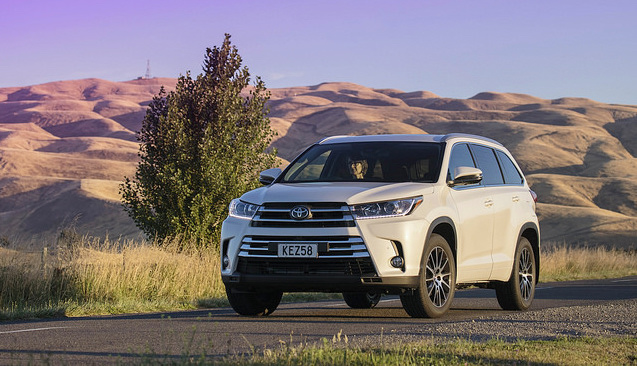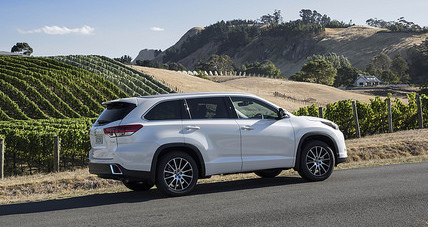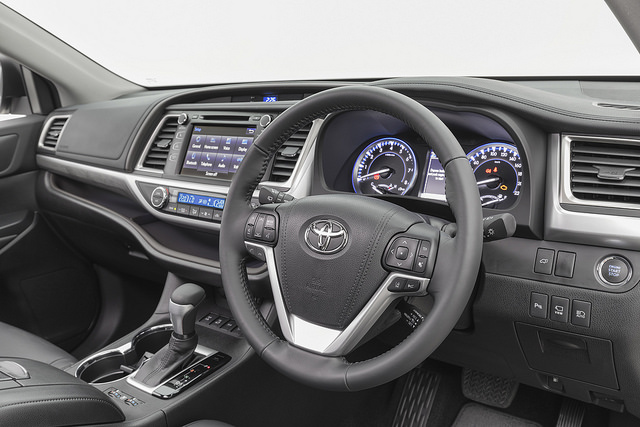
Behind the alphabet soup that denotes new technology in the updated Toyota Highlander SUV is the 3.5-litre V6 engine and eight-speed automatic gearbox from the company’s premium brand, Lexus.
The Highlander is the first Toyota to use the pairing, specifically put together to improve performance, economy, and exhaust emissions in both the two- and four-wheel-drive models. All other Toyota SUVs use six-speed gearboxes.
Toyota claims town-and-around fuel use for the new-look Highlander of 9.5 litres/100km (30mpg) for the four-wheel drive and 9.1 litres/100km (31mpg) for the two-wheel drive. That’s roughly 1 litre/100km less than the outgoing model consumes, or a cut in exhaust C02 of 25gr/km.
The efficiencies go hand-in-hand with a boost in naturally aspirated performance: power is up from 201kW to 218kW and torque from 337Nm to 350Nm. The same V6 engine in the Lexus line-up delivers a little more oomph – 221kW and 370Nm.
Now we come to the alphabet soup. There are three specification levels: GX, GXL, Limited. The Highlander engine – coded 2GR-FKS – is the first with a Toyota stamp to combine both VVT-iW with D-4S technology, a Lexus offering.
VVT is variable valve timing; i-W is the intake valve and its ability to switch the engine to the fuel-saving Atkinson cycle under light throttle loads. D4-S is the fuel-injection system, which can switch between port and direct injection for optimum efficiency.
The eight-speed gearbox is variable, too, like other multi-gear ‘boxes. Go back a few years and a five-speed automatic was exactly that. Slip it into Drive and, under throttle, it and the torque converter engaged first gear, then second, and so on up as it stepped up and down ratios.
Modern, computer-managed gearboxes work more in harmony with throttle loads. Toyota’s eight-speeder might engage second gear to get underway. It might go from second to fourth, then to sixth, skipping third and fifth. It might decide that going from eighth to fifth or sixth offers more efficiency than eighth to seventh.
As a Toyota technician said: “You can’t tell your mates your new car has got 10 gears and would they like to go for a drive so you can show them how each one works. This transmission technology isn’t like that at all.”
The seven-seat Highlander gets a fresh look, highlighted by a trapezoidal grille with silver accents and flanked by halogen headlights and LED daytime running lights. All models pick up LED tail-lights and trailor-sway control.
But only the top-spec Limited gets the complete Toyota Safety Sense (TSS) package, a bundle that includes pre-crash automatic braking. The Limited is also the only model with a live 360-degree monitor, which provides the driver with bird’s eye view around the vehicle.
Inside, the GX and GXL models gain a 4.2-inch colour information display, while the Limited gets a larger 8-inch display and now features satellite navigation with traffic alerts.
The four-wheel drive GX is priced at $63,490, the four-wheel drive GXL at $70,490, the Limited four-wheel drive at $81,490. The GXL two-wheel drive is $66,490.
- The Highlander first appeared in New Zealand in 2003 as a four-wheel drive with five or seven seats and powered by a 3.3-litre petrol V6. Three spec levels were available: the entry-level five-seater at $52,850, the mid-range seven-seater at $54,850, and the premium seven-seater Limited at $63,950. The two-wheel drive variant was introduced in 2014, soon after the launch of the current model. At the end of last month, Toyota NZ had sold 15,321 Highlanders.



